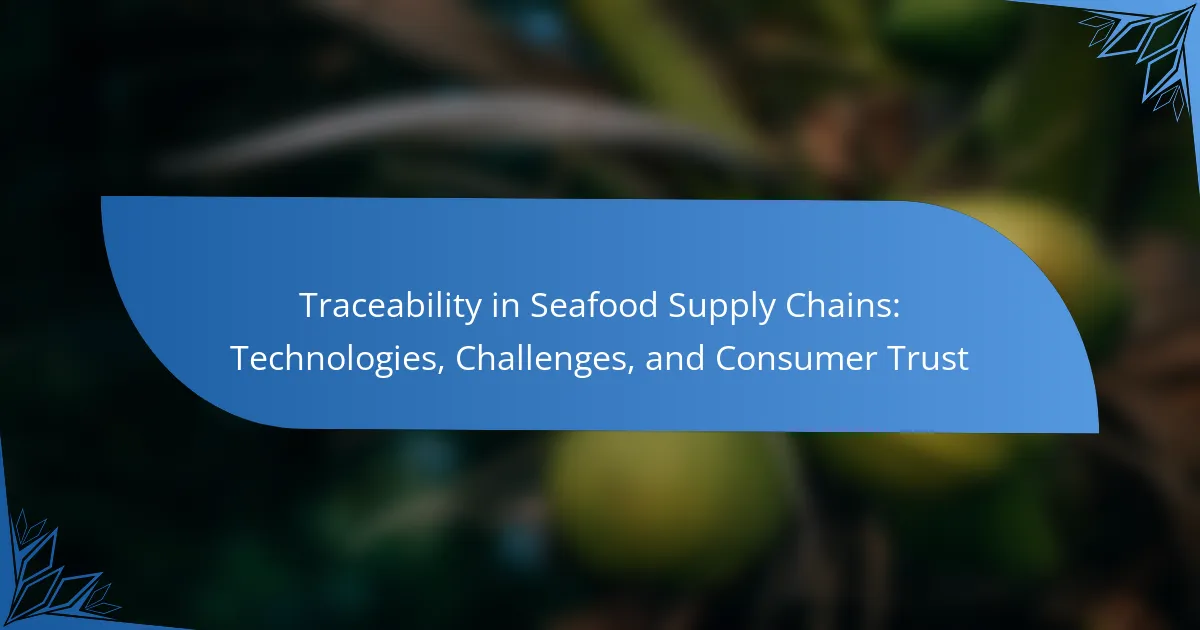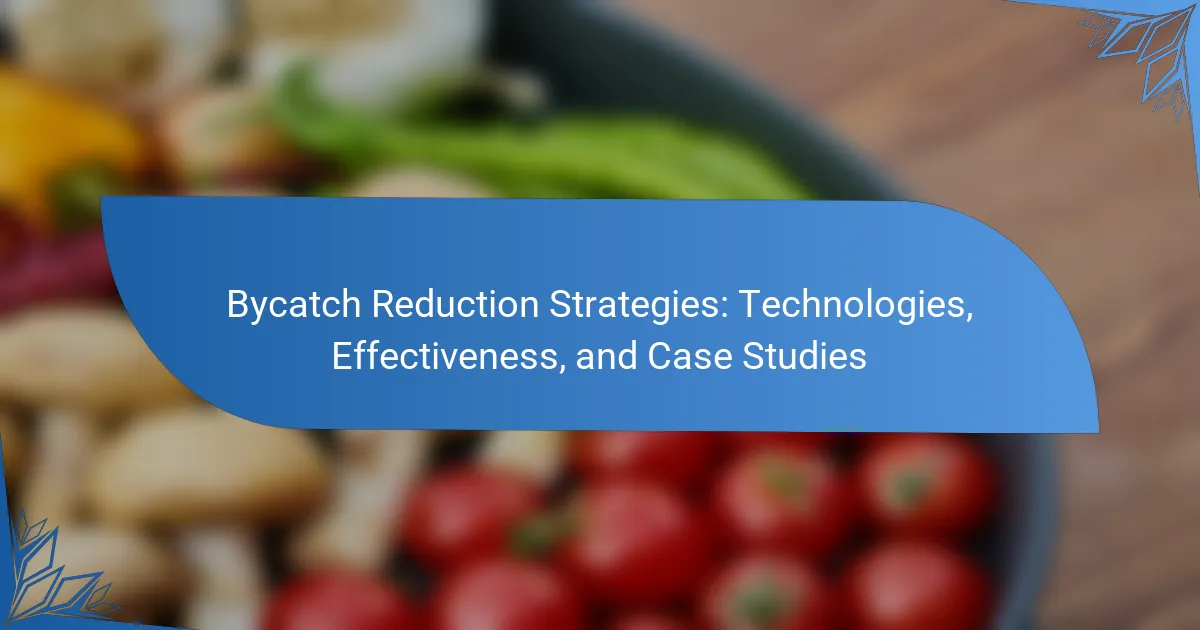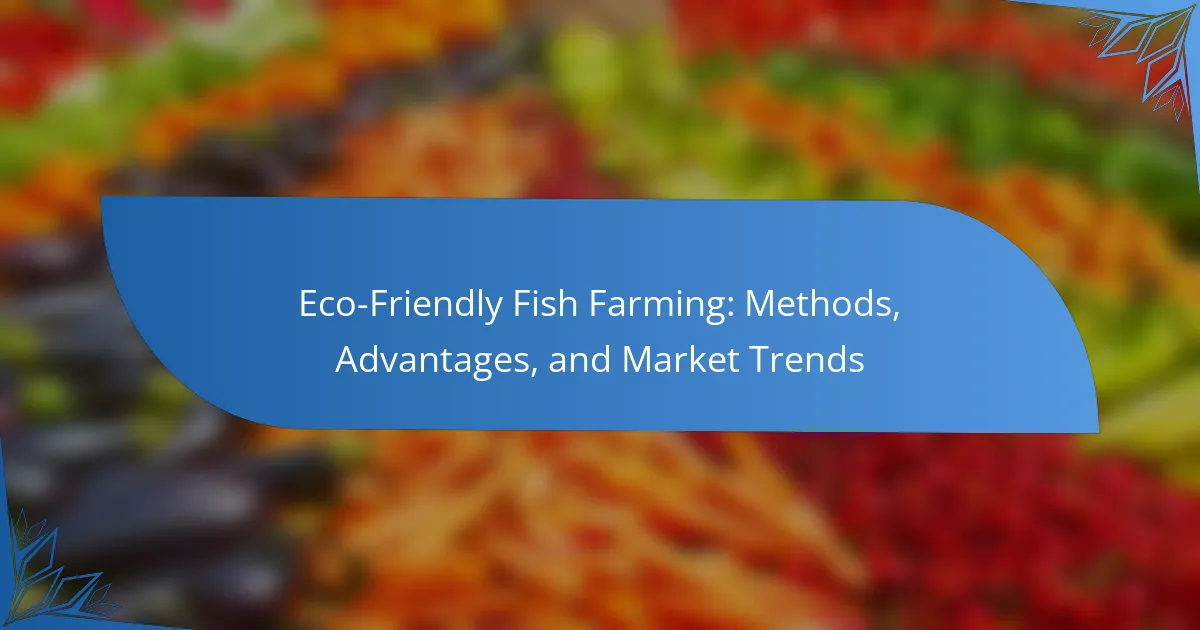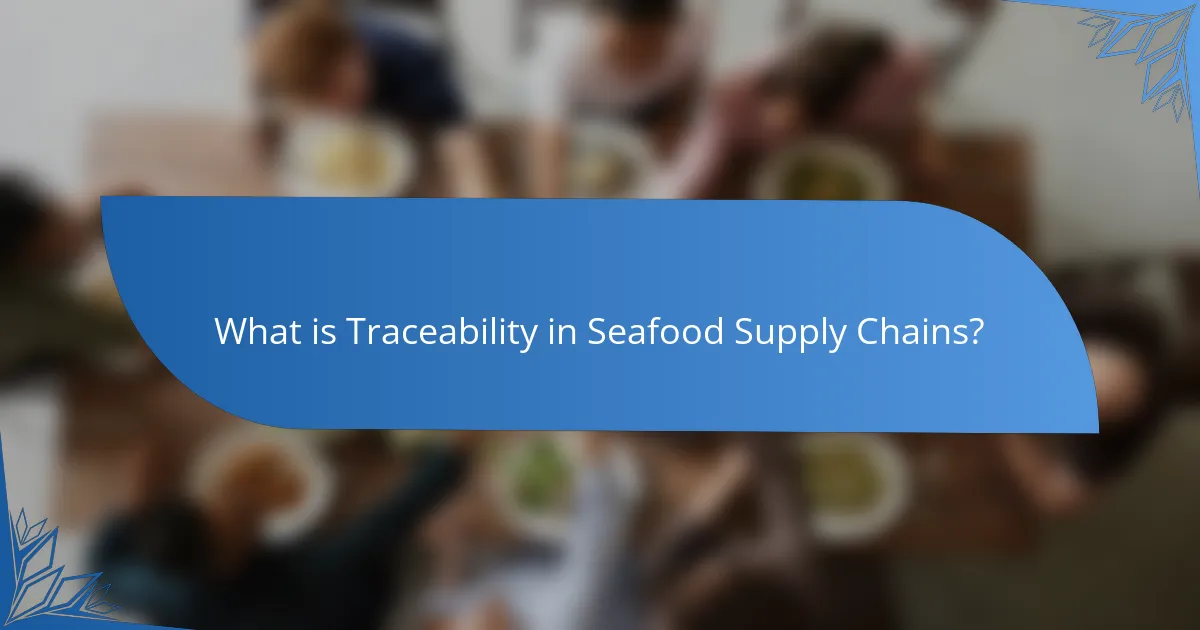
What is Traceability in Seafood Supply Chains?
Traceability in seafood supply chains refers to the ability to track the journey of seafood products from their origin to the consumer. It involves documenting each stage of the supply chain, including harvesting, processing, and distribution. This process ensures transparency and accountability in seafood sourcing. Traceability helps prevent illegal fishing and ensures compliance with regulations. It also enables consumers to verify the sustainability and quality of seafood products. Studies show that traceability can enhance consumer trust and drive demand for responsibly sourced seafood. The implementation of digital technologies, such as blockchain, further strengthens traceability efforts in the seafood industry.
How does traceability function within seafood supply chains?
Traceability in seafood supply chains ensures the tracking of seafood products from catch to consumer. It functions through a series of documented steps that record each stage of the supply chain. Information is collected at various points, including harvesting, processing, and distribution. Technologies such as RFID, blockchain, and QR codes are often used to facilitate this tracking. These technologies provide real-time data and enhance transparency. Traceability helps to verify the origin of seafood, ensuring it is sustainably sourced. It also aids in identifying sources of contamination during food safety incidents. According to the FAO, effective traceability can significantly reduce the risk of fraud and improve consumer trust in seafood products.
What technologies are used to enable traceability in seafood?
Technologies used to enable traceability in seafood include blockchain, RFID, and IoT devices. Blockchain provides a secure and transparent ledger for tracking seafood from source to consumer. RFID tags allow for real-time tracking of seafood products throughout the supply chain. IoT devices collect data on environmental conditions and handling practices during transportation. These technologies enhance transparency and accountability in seafood sourcing. According to a study by the Food and Agriculture Organization, implementing these technologies can significantly reduce fraud and improve food safety.
What data is collected for traceability purposes?
Data collected for traceability purposes includes information about the origin of seafood, processing methods, and distribution channels. This data typically encompasses details such as catch location, species identification, and harvest dates. Additionally, it involves tracking the handling and processing stages, including temperature control and processing dates. Documentation of transportation conditions and storage practices is also essential. Regulatory compliance data, such as certifications and inspections, contributes to traceability. This comprehensive data collection ensures transparency and accountability throughout the seafood supply chain.
Why is traceability important in the seafood industry?
Traceability is important in the seafood industry because it ensures the safety and quality of seafood products. It allows for the tracking of seafood from catch to consumer. This process helps to identify sources of contamination or fraud. According to a study by the Marine Stewardship Council, 70% of consumers prefer seafood with traceable origins. Traceability also supports sustainable fishing practices by monitoring fish stocks. Additionally, it enhances consumer trust in seafood products. Regulatory agencies require traceability to enforce safety standards. Overall, traceability mitigates risks associated with seafood supply chains.
What benefits does traceability provide to consumers?
Traceability provides consumers with enhanced transparency regarding the origin and journey of seafood products. It allows consumers to verify the source of their food, ensuring it meets safety and quality standards. Traceability reduces the risk of food fraud, as consumers can confirm the authenticity of the seafood they purchase. Furthermore, it enables consumers to make informed choices about sustainability and ethical sourcing. Research indicates that 73% of consumers are more likely to purchase seafood with clear traceability information. This confidence in product integrity fosters trust between consumers and suppliers.
How does traceability contribute to sustainability in seafood sourcing?
Traceability enhances sustainability in seafood sourcing by ensuring accountability throughout the supply chain. It allows consumers to verify the origin of seafood products. This verification helps prevent overfishing and illegal fishing practices. Studies indicate that traceable seafood leads to better management of fish stocks. For example, the Marine Stewardship Council reports that certified fisheries show improved sustainability practices. Traceability also encourages responsible sourcing from certified sustainable fisheries. This fosters consumer trust and promotes environmentally friendly choices. As a result, traceability becomes a crucial tool for supporting sustainable seafood practices.
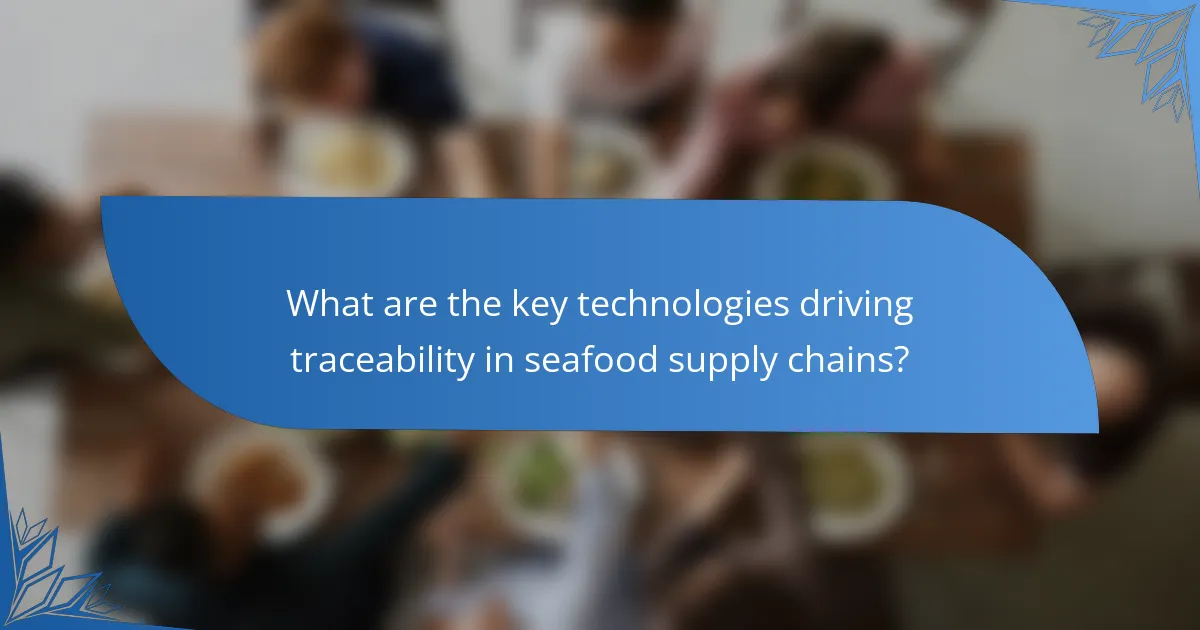
What are the key technologies driving traceability in seafood supply chains?
Key technologies driving traceability in seafood supply chains include blockchain, IoT, and RFID. Blockchain provides a secure, immutable ledger for tracking seafood from catch to consumer. IoT devices collect real-time data on seafood conditions during transport and storage. RFID tags enable efficient tracking and inventory management throughout the supply chain. These technologies enhance transparency and trust among consumers. Studies show that blockchain can reduce fraud by up to 50%. IoT integration can improve supply chain efficiency by 30%. RFID technology allows for quicker responses to recalls, ensuring food safety.
How do blockchain and IoT enhance traceability?
Blockchain and IoT enhance traceability by providing real-time data and immutable records. Blockchain creates a secure, decentralized ledger that records each transaction in the supply chain. This ensures transparency and prevents tampering with data. IoT devices, such as sensors and RFID tags, collect data on seafood conditions during transport. They monitor temperature, location, and handling practices. The integration of these technologies allows stakeholders to track products from ocean to table. Studies show that using blockchain can reduce fraud by up to 80% in supply chains. This combination fosters consumer trust by ensuring product authenticity and safety.
What role does blockchain play in ensuring data integrity?
Blockchain plays a crucial role in ensuring data integrity by providing a decentralized and immutable ledger. This technology records transactions in a way that prevents alteration or deletion. Each block in the chain contains a unique cryptographic hash of the previous block, linking them securely. This makes it nearly impossible for unauthorized changes to occur without detection.
In seafood supply chains, blockchain enhances traceability by allowing all stakeholders to access a single version of the truth. This transparency fosters trust among consumers and businesses alike. Additionally, the use of smart contracts automates compliance checks, ensuring that data remains accurate throughout the supply chain.
A study by Kshetri (2018) highlights that blockchain’s characteristics can significantly reduce fraud and errors, thereby improving data integrity in various sectors, including food safety.
How does IoT facilitate real-time tracking of seafood products?
IoT facilitates real-time tracking of seafood products through the use of connected devices and sensors. These devices monitor various conditions such as temperature, humidity, and location during transportation. Data collected is transmitted to a central system for analysis. This ensures that seafood remains within safe parameters throughout the supply chain.
For instance, RFID tags can be attached to seafood containers. These tags provide continuous updates on the product’s journey from ocean to table. GPS technology further enhances tracking by providing precise location data.
Research indicates that IoT adoption in seafood logistics improves traceability and reduces spoilage rates by up to 20%. This level of monitoring builds consumer trust by ensuring product quality and safety.
What other technologies support traceability efforts?
Blockchain technology supports traceability efforts in seafood supply chains. It provides a decentralized ledger that records every transaction. This ensures transparency and accountability throughout the supply chain. RFID (Radio Frequency Identification) technology also enhances traceability. It allows for real-time tracking of seafood products from source to consumer. IoT (Internet of Things) devices collect data on environmental conditions during transportation. This information helps maintain quality and safety standards. QR codes enable consumers to access product information easily. They can verify the origin and journey of seafood products. Together, these technologies improve traceability and foster consumer trust.
What is the impact of RFID technology on seafood traceability?
RFID technology significantly enhances seafood traceability. It allows for real-time tracking of seafood from catch to consumer. RFID tags store detailed information about the product, such as origin, processing history, and storage conditions. This data can be accessed quickly and efficiently, improving transparency in the supply chain. Studies show that using RFID can reduce the time required for inventory management by up to 30%. Enhanced traceability through RFID helps in ensuring food safety and quality control. It also builds consumer trust by providing verifiable information about seafood products. Overall, RFID technology plays a crucial role in modernizing seafood supply chains.
How do mobile apps contribute to consumer transparency?
Mobile apps contribute to consumer transparency by providing real-time access to product information. They allow consumers to track the sourcing and journey of seafood from ocean to plate. Users can scan QR codes or barcodes to view details about the product’s origin, including fishing methods and sustainability practices. This immediate access to data empowers consumers to make informed choices. Studies show that 70% of consumers prefer brands that provide transparency about their supply chains. By enhancing visibility, mobile apps build trust between consumers and seafood suppliers, fostering a more responsible consumption culture.
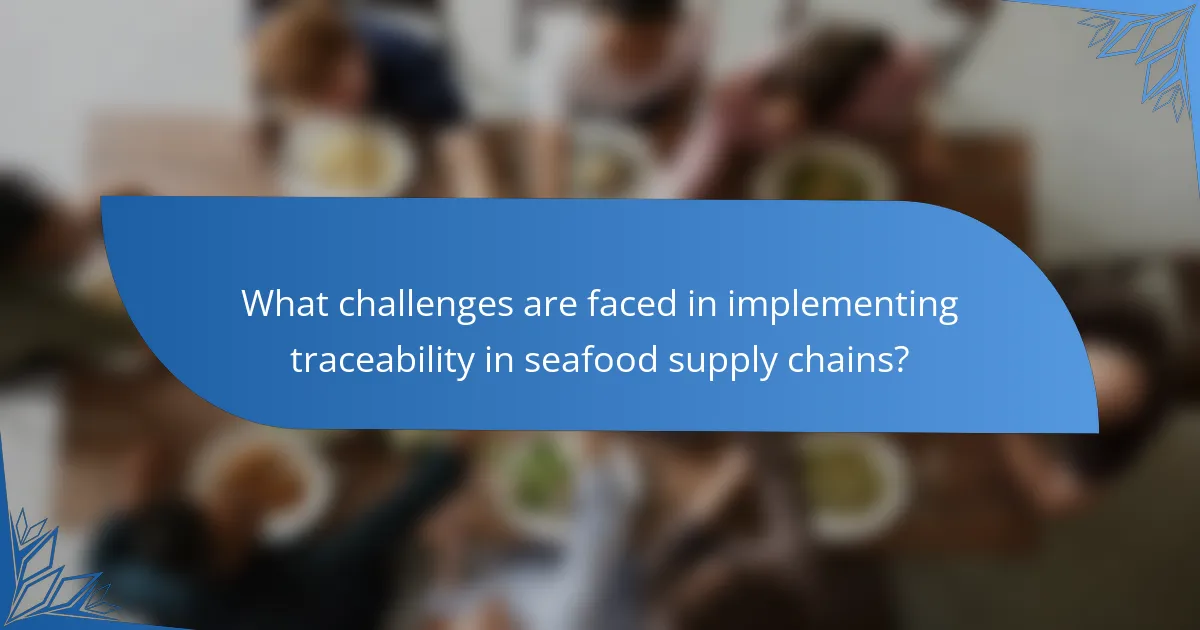
What challenges are faced in implementing traceability in seafood supply chains?
Implementing traceability in seafood supply chains faces several challenges. One major challenge is the lack of standardized data formats across the industry. Different stakeholders often use varying systems, complicating data sharing. Another issue is the high costs associated with technology adoption. Many small-scale fishers cannot afford advanced tracking systems. Additionally, there is a lack of regulatory frameworks in many regions. This absence can lead to inconsistent practices and compliance issues. Furthermore, the complexity of global supply chains complicates tracking. Seafood often passes through multiple hands before reaching consumers. Lastly, consumer awareness and demand for transparency are still developing. Many consumers do not prioritize traceability, affecting market incentives.
What are the common obstacles to achieving full traceability?
Common obstacles to achieving full traceability include data fragmentation, lack of standardization, and inadequate technology. Data fragmentation occurs when information is scattered across multiple systems. This makes it difficult to compile comprehensive records. Lack of standardization refers to the absence of uniform protocols for data collection and sharing. Without standard guidelines, different stakeholders may use incompatible systems. Inadequate technology can hinder the capture and transmission of data. Many supply chain participants may not have access to advanced tracking tools. Additionally, high implementation costs can deter businesses from adopting necessary technologies. These factors collectively impede the ability to establish a seamless traceability system in seafood supply chains.
How do regulatory issues affect traceability initiatives?
Regulatory issues significantly impact traceability initiatives by establishing mandatory compliance standards. These regulations dictate how seafood products must be tracked from source to consumer. Compliance can require investment in technology for data collection and reporting. For instance, the European Union’s General Food Law mandates traceability for all food products. This law obliges seafood suppliers to maintain detailed records of their supply chain. Failure to comply can lead to severe penalties, including fines and product recalls. Additionally, regulatory frameworks can enhance consumer trust by ensuring food safety and quality. Overall, regulations shape the operational landscape for traceability initiatives in seafood supply chains.
What technological limitations hinder effective traceability?
Technological limitations that hinder effective traceability include lack of standardized data formats and interoperability between systems. Many traceability systems use different technologies, making data sharing difficult. Insufficient real-time data collection can lead to outdated information. Limited access to advanced technologies in some regions restricts implementation. High costs of sophisticated traceability solutions can deter adoption. Data security concerns may prevent stakeholders from sharing critical information. Additionally, inadequate training for personnel can impede the effective use of traceability technologies. These limitations collectively impact the overall efficiency of traceability in seafood supply chains.
How do cultural and economic factors impact traceability?
Cultural and economic factors significantly impact traceability in seafood supply chains. Cultural attitudes toward food safety and transparency influence consumer expectations. In regions where consumers prioritize sustainability, traceability becomes a critical demand. This demand drives businesses to adopt more rigorous tracking systems. Economic factors, such as market competition, also play a role. Companies invest in traceability technologies to differentiate their products. For instance, higher-value seafood products often have more advanced traceability systems. Research indicates that regions with stringent regulations see improved traceability outcomes. The interplay between culture and economy shapes the effectiveness of traceability initiatives.
What challenges do small-scale fisheries face in adopting traceability?
Small-scale fisheries face several challenges in adopting traceability. Limited access to technology hinders their ability to implement tracking systems. High costs associated with traceability solutions can be prohibitive for these fisheries. Lack of knowledge and training on traceability practices further complicates adoption. Additionally, fragmented supply chains create difficulties in maintaining consistent data. Regulatory requirements can also be overwhelming for small-scale operators. Finally, consumer demand for traceability may not always translate into market incentives for small-scale fisheries.
How does consumer demand influence traceability practices?
Consumer demand significantly influences traceability practices in seafood supply chains. As consumers increasingly seek transparency regarding the origins of their food, companies respond by enhancing traceability systems. This demand for information drives businesses to adopt technologies that track products from source to shelf. For instance, a survey by the Marine Stewardship Council found that 73% of consumers prefer sustainably sourced seafood with traceable origins. Consequently, companies invest in digital tools, such as blockchain, to ensure accurate tracking of seafood products. Enhanced traceability not only meets consumer expectations but also builds trust in the brand. Ultimately, consumer preferences shape the development and implementation of traceability practices in the seafood industry.

How does traceability build consumer trust in seafood products?
Traceability builds consumer trust in seafood products by ensuring transparency and accountability in the supply chain. It allows consumers to verify the origin and journey of the seafood they purchase. When consumers can trace seafood back to its source, they feel more assured about its quality and safety. Traceability systems often include detailed records of catch locations, handling practices, and processing methods. This information helps consumers make informed choices. Studies show that consumers are willing to pay a premium for seafood with traceability certifications. For instance, a survey by the Marine Stewardship Council found that 75% of consumers prefer certified sustainable seafood. This preference indicates a strong correlation between traceability and consumer confidence.
What role does transparency play in consumer confidence?
Transparency significantly enhances consumer confidence. It provides clear information about product origins and quality. In seafood supply chains, transparency helps consumers verify sourcing and sustainability. Studies show that 73% of consumers are willing to pay more for transparent products. Transparency reduces uncertainty and builds trust between consumers and brands. When consumers understand the supply chain, they feel more secure in their purchases. This trust leads to increased loyalty and repeat business. Ultimately, transparency is crucial for fostering consumer confidence in seafood products.
How do certifications and labels affect consumer perceptions?
Certifications and labels significantly influence consumer perceptions by signaling quality and trustworthiness. Consumers often associate certifications with higher standards and safety. For instance, seafood products with sustainability labels tend to be viewed more favorably. Research shows that 66% of consumers are willing to pay more for certified products. This indicates that certifications enhance perceived value. Labels also help consumers make informed choices, fostering a sense of responsibility. In the seafood industry, certifications like Marine Stewardship Council (MSC) boost consumer confidence in sustainability claims. Ultimately, certifications and labels shape consumer trust and purchasing decisions.
What information do consumers seek regarding seafood sourcing?
Consumers seek information about the origins of seafood, including where it was caught or farmed. They want details on the fishing methods used, such as whether they are sustainable or harmful to the environment. Information on certifications, like Marine Stewardship Council (MSC) or Aquaculture Stewardship Council (ASC), is also important. Consumers are interested in the supply chain transparency, including how seafood is processed and transported. They often look for evidence of ethical labor practices in the sourcing process. Additionally, consumers may seek information on the freshness and quality of the seafood. They are increasingly concerned about the potential presence of contaminants or additives in seafood products. Studies show that 73% of consumers prefer seafood with clear traceability information.
What best practices can enhance traceability and trust?
Best practices that can enhance traceability and trust in seafood supply chains include implementing blockchain technology, which provides a secure and immutable record of transactions. This technology allows all stakeholders to access real-time data about the product’s journey. Regular audits and certifications by third-party organizations also ensure compliance with safety and sustainability standards. Transparency in sourcing and processing practices fosters consumer confidence. Additionally, educating consumers about the traceability processes increases their trust in the product. Collaborative efforts among suppliers, retailers, and regulators improve information sharing and accountability. Research by the Food and Agriculture Organization highlights that traceability systems can significantly reduce fraud and increase consumer trust.
How can seafood businesses improve their traceability systems?
Seafood businesses can improve their traceability systems by implementing blockchain technology. Blockchain provides a secure and transparent method for tracking seafood from catch to consumer. Each transaction is recorded in real-time, ensuring accurate data sharing among all stakeholders. This technology enhances trust and accountability in the supply chain. According to a study by the World Wildlife Fund, blockchain can reduce fraud and mislabeling in seafood products by over 30%. Additionally, businesses can adopt RFID tags for real-time tracking. RFID technology allows for efficient monitoring of seafood throughout the supply chain. By combining these technologies, seafood businesses can significantly enhance their traceability systems.
What steps can consumers take to verify seafood traceability?
Consumers can verify seafood traceability by checking labels for certification. Look for third-party certifications like the Marine Stewardship Council (MSC) or Aquaculture Stewardship Council (ASC). These labels indicate adherence to sustainability and traceability standards. Additionally, consumers can ask retailers for information about the seafood’s source. Many retailers provide details about the catch location and fishing methods. Using seafood traceability apps can also help. These apps allow consumers to scan barcodes or QR codes for detailed supply chain information. Engaging with brands on social media can provide insight into their sourcing practices. Finally, consumers should research seafood companies to understand their commitment to traceability and sustainability.
Traceability in seafood supply chains refers to the ability to track seafood products from their origin to the consumer, ensuring transparency and accountability throughout the supply chain. This article explores the technologies that enable traceability, including blockchain, RFID, and IoT, while addressing the challenges faced in implementation, such as data fragmentation and regulatory issues. It highlights the importance of traceability for consumer trust, safety, and sustainability, emphasizing the data collected and the role of certifications in enhancing consumer perceptions. Finally, best practices for improving traceability systems and steps consumers can take to verify seafood traceability are discussed.
